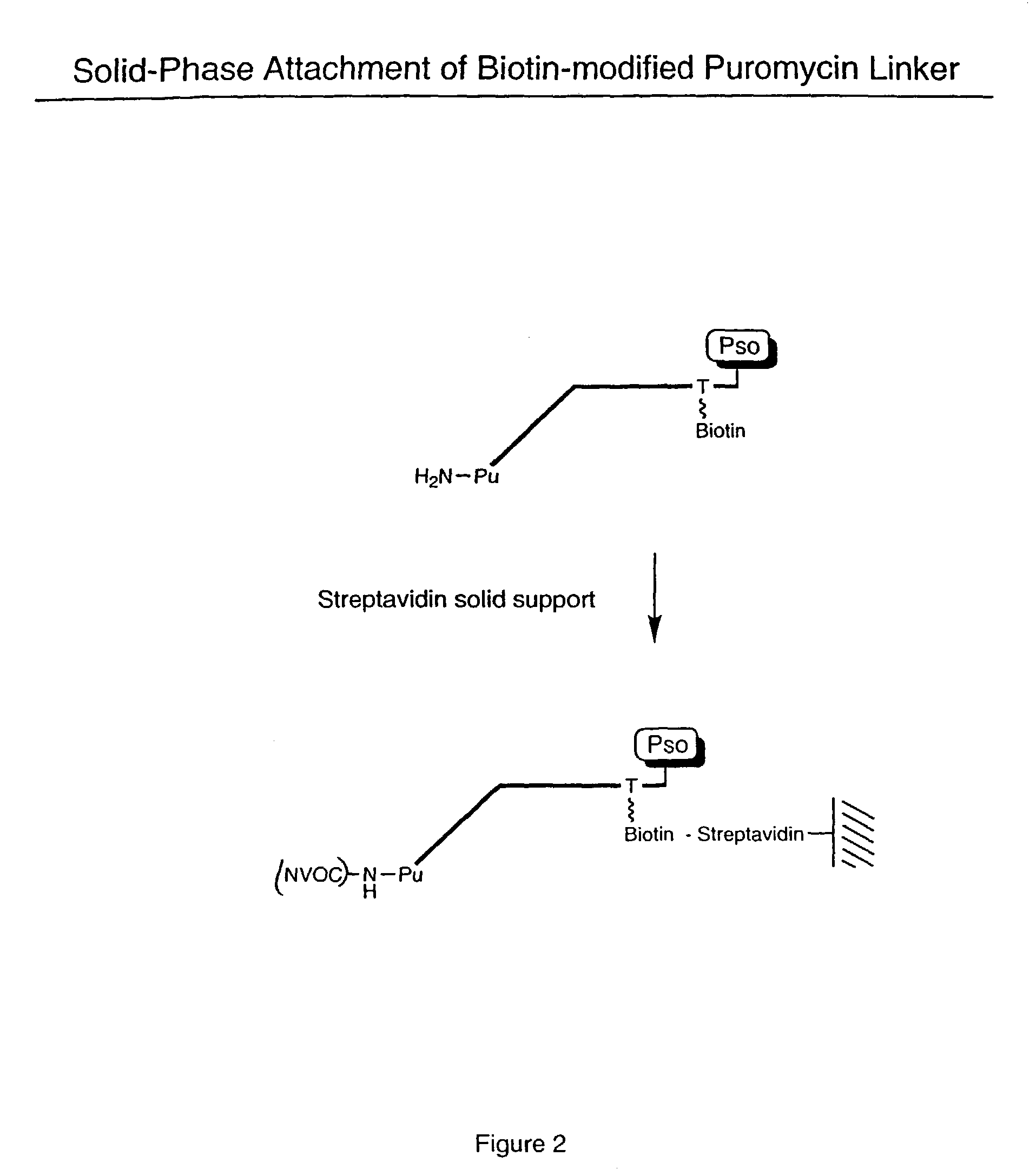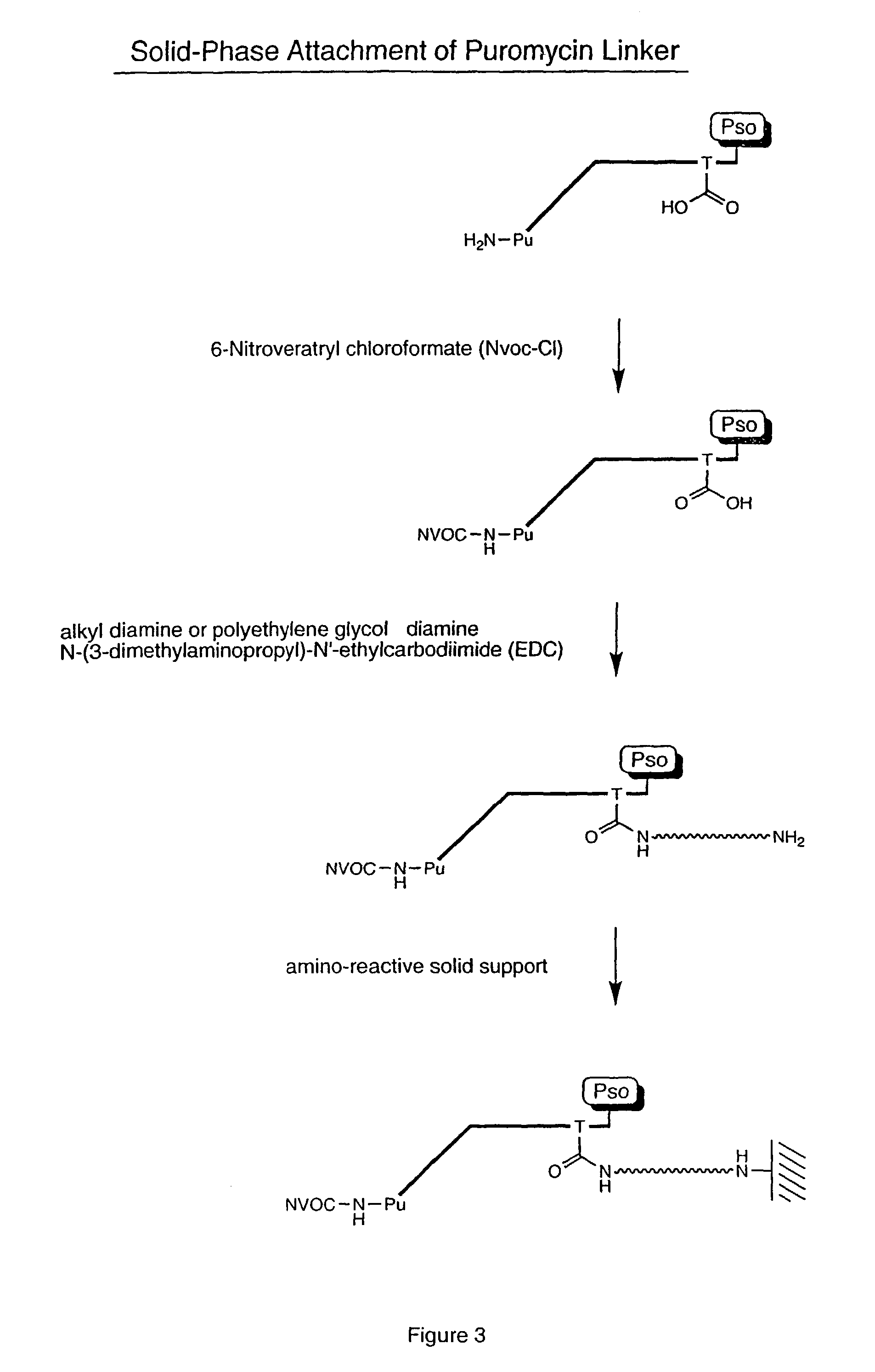Solid-phase immobilization of proteins and peptides
a technology of proteins and solid supports, applied in the field of solid-phase immobilization of proteins and peptides, can solve the problems of difficult isolation of compounds that bind specifically to biologically important molecules, difficult immobilization and screening of proteins, and inability to use all proteins, etc., to achieve easy purification, less restrictions, and easy to work.
- Summary
- Abstract
- Description
- Claims
- Application Information
AI Technical Summary
Benefits of technology
Problems solved by technology
Method used
Image
Examples
example 1
Periodate Oxidation, Biotinylation of RNA
[0058]For this illustrative example, the RNA encodes a peptide having the amino acid sequence:[0059]MVSDVPRDLEVVAATPTSLLISWKTHEVAARYYRITYGETGGNSPVQEFTVPPW ASIATISGLKPGVDYTITVYAVTPLRWTETEAHIPIPINYRT (SEQ. ID NO: 1) The RNA was modified to allow attachment to a solid phase. Modification of the RNA was performed by periodate oxidation of the 3′-terminal ribose (Agrawal Methods in Molecular Biology, Agrawal ed. Vol. 26, Totowa: Human Press, pp. 93–120 (1994)). This was accomplished by mixing 18 μL of RNA (10 μM), 10 μL of NaIO4 (0.5 M), and 3.3 μL of NaOAc (0.1 M) in 68.7 μL of water and incubating for 15 minutes at room temperature.
[0060]Following incubation, the sample was precipitated with a solution of 260 μL H2O, 40 μL NaOAc (3 M), and 1 mL EtOH, and re-suspended in 90 μL NaOAc (0.1 M). 10 μL of Biotin-LC-hydrazide, 50 mM (Pierce, Rockford, Ill.) was added. The mixture was incubated for 2 hours at room temperature and precipitated with NaOAc...
example 2
On-Bead Fusion Formation
[0061]Biotinylated RNA was immobilized on a solid support by mixing 3 μL Bio RNA (and non-biotinylated control), 50 μL buffer (25 mM Tris, pH 7.0; 0.25% Tween), and 25 μL Neutravidin agarose beads. The mixture was incubated at room temperature for 10 minutes and spun in a Microspin column, followed by washing (2×) with 100 μL of buffer (1% BSA in PBS; 0.25% Tween) and washing (2×) with 100 μL of PBS / 0.25% Tween buffer. A translation reaction was performed (see, e.g., Roberts & Szostak, Proc. Natl. Acad. Sci. USA, 1997, 94:12297 or Liu et al., Methods Enzymol., 2000, 318:268) by adding 100 μL lysate mix containing [35S] Methionine. The mixture was rotated for 1 hour at 30° C. The mixture was then spun and 200 μL of 0.5 M KCl and 0.1 M MgCl2 were added to promote RNA-protein fusion formation. The mixture was incubated for 1 hour at room temperature, spun, and washed (5×) with 100 μL PBS buffer. The sample was re-suspended in 100 μL of buffer and the successful ...
example 3
On-Membrane Fusion Formation
[0062]Biotinylated RNA was diluted 1:5, 1:10, 1:20, 1:40, and 1:80 into 25 mM buffer (Tris, pH 7.0; 0.25% Tween-20). 3 μL aliquots were spotted on a dry streptavidin membrane (SAM™ Biotin Capture membrane, Promega, Madison, Wis.). The filter was then washed with buffer (1% BSA in PBS, pH 7.6; 0.25% Tween) and left to dry. A translation reaction was performed by soaking the filter with lysate ([35S] Methionine) and incubating for 1 hour at 30° C. 0.5 M KCl and 0.1 mM MgCl2 were added and the mixture was incubated for 1 hour at room temperature. The filter was then washed for 10 minutes with PBS buffer, rinsed thoroughly, dried, and exposed to a phosphorimager screen for analysis.
PUM
| Property | Measurement | Unit |
|---|---|---|
| pH | aaaaa | aaaaa |
| insoluble | aaaaa | aaaaa |
| covalent | aaaaa | aaaaa |
Abstract
Description
Claims
Application Information
 Login to View More
Login to View More - R&D
- Intellectual Property
- Life Sciences
- Materials
- Tech Scout
- Unparalleled Data Quality
- Higher Quality Content
- 60% Fewer Hallucinations
Browse by: Latest US Patents, China's latest patents, Technical Efficacy Thesaurus, Application Domain, Technology Topic, Popular Technical Reports.
© 2025 PatSnap. All rights reserved.Legal|Privacy policy|Modern Slavery Act Transparency Statement|Sitemap|About US| Contact US: help@patsnap.com



